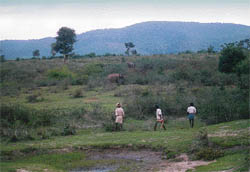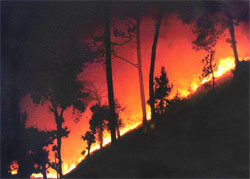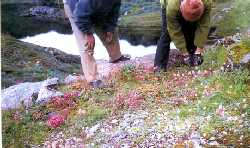
Forests of global contention
The South"s determined efforts to scuttle the forest convention that the North was adamant on pushing through was a major triumph. A blow-by-blow account of the crucial, often tricky, negotiation

The South"s determined efforts to scuttle the forest convention that the North was adamant on pushing through was a major triumph. A blow-by-blow account of the crucial, often tricky, negotiation
People collect rainwater without any support from the government. This saves the avoidable overuse of drinking water

Recent studies indicate increasing pollution may be hampering the atmosphere's inherent cleansing abilty
More than a million people die every year because the government cannot ensure clean air and water. In the years to come, this number will rise further, unless strong steps are taken to start controlling pollution right away
The Aral Sea crisis exemplifies " creeping environmental problems", and unless India's environment ministers devote more time to natural resource management, we will multiply tragedies like Kalahandi and Palamau
Call it paranoia or plain silliness. But it is amazing. The Centre for Science and Environment cse has been studying gas pricing in the country to assess how environmentally acceptable fuels can be

Twelve of the deadliest toxins known to humans were recently the focus of a debate between 92 nations seeking ways and means to curb their use

Hydroelectricity can now be generated without the need of costly civil works and installation of complex machinery
The widespread and diverse use of gobar in Indian society stands up to every principle of good environmentalism. Cowdung is a waste product. Yet, instead of being looked down upon, it is highly respected
Pakistan lacks a comprehensive energy efficiency development road map and investment programme and international experience indicates that the effective implementation and incorporation of energy efficiency into the policy mainstream requires concerted, long-term action and commitment, said Asian Development Bank report. In a project update report on 'Preparing the Sustainable Energy Efficiency Development Programme for Pakistan', the ADB emphasised the need for a comprehensive policy and regulatory framework; energy price and utility rate-setting reforms and incentives; a strong equipment standards, certification, and testing regime; complementary alternative and renewable energy programmes; and easy, widespread access to energy efficiency information, financing, products, and services by all categories and levels of energy market players and end users. According to ADB project study, the energy efficiency assessment conducted under ADB's Energy Efficiency Initiative determined that Pakistan has a large and untapped energy efficiency market. It identifies several energy efficiency improvement opportunities in gas distribution (supply side) and in the government and residential sectors (demand side) that can be tapped into. These opportunities may be explored without extensive precursor preparations, detailed policy design, or framework development, achieving immediate energy savings and deferring additional supply requirements. Further refinement and expansion of such options could result in a portfolio of immediate, bankable energy efficiency investment options for Pakistan, which the government and ADB may consider. According to report, the government and domestic consumers consume more than 60 percent of Pakistan's energy. The public sector is the most inefficient consumer, and the government is looking for more efficient utilisation and conservation measures. The government is eager to procure and adopt energy efficient technology in its operations, including the use of efficient lighting and heating and cooling systems in existing and new buildings, and introduction of energy-efficient building codes. The domestic sector currently uses 45 percent of the power supply. The most effective way to expedite the use of efficient compact fluorescent lamps by domestic consumers is to inject a large volume of such lamps into the market at a low price. This approach has been successful in several countries, where it has immediately reduced customers' monthly power bills. Preliminary analysis suggests that the introduction of 15 million high-quality compact fluorescent lamps into Pakistan's domestic market would save customers $78 million over the lifetime of those bulbs (approximately 2 years). This money could be used more productively in the economy. In addition, 880 MW of power demand would be avoided. The cost of such additional new generation capacity would be $1.15 billion (at $1.3 million per MW), ADB report disclosed. ADB report further pointed out that Pakistan's gas distribution system is ageing and is suffering from high technical losses (25-30 percent in some areas compared to industry standard 5 percent) that could be eliminated by replacing medium and low pressure pipes with more efficient, corrosion-free pipes. Natural gas accounted for half (43 billion cubic meters) of Pakistan's primary energy supply in 2006. A more efficient gas distribution system would result in significant national savings (up to $580 million per year) and increased use of cleaner fuel by more domestic, industrial, and commercial consumers, ADB report mentioned. It said that Electricity consumption, projected to grow an average of 8 percent per annum until 2015 (although recent experience suggests much higher demand growth), will similarly require large power generation capacity additions. Higher energy demand and imports will also require massive investments in associated port terminals, storage facilities, refining capacity, pipeline and transmission networks, and surface fuel transport infrastructure. During 2001-2006, ADB report stated that primary energy supply increased 5.4 percent per year. Meanwhile, consumption of electricity rose at an average annual rate of 6.8 percent, natural gas by 10.4 percent, liquefied petroleum gas by 17.6 percent, and coal by 22.8 percent. Electricity use, in particular, is growing robustly across all sectors-industry, agriculture, domestic, and commercial-recording a 10.2 percent overall jump in 2005-2006, while generation increases lagged at 9.3 percent during the same period. Copyright Business Recorder, 2008

Large scale habitat loss and massive encroachment of the forestland have escalated the instances of wildlife human conflict in recent times

Controlled burning of woodlands can be an effective tool for enriching the land and ecology. <b><i>Dipanjan Ghosh</i></b> looks at the possibilities

Ethnic veterinary medicine is effective, cheap and accessible. Above all, it recognises the fact that no one knows an animal better than its keeper

Industrial fishing is fast gobbling up the world's marine resources. Worldwide concern for this humanmade catastrophe has forced nations to draw up a Code of Conduct for Responsible and Sustainable Fishing. But will this non mandatory treaty hold out agai

To villagers in Bihar, the Dunkel Draft and GATT are not proposals or agreements but a couple of angrez out to play havoc with their lives.

The race for a bleak future starts with these nuclear tests

There is something seriously amiss in the way studies of wildlife have been conducted in Sikkim

The Apatanis manage their forests well. So, they never have to buy wood from markets

An offer of desi ber by a village lad came as a sharp comment on the global politics of biodiversity

Acquiring prime forest land near town and highway and then selling it at an exorbitant price has become routine in the state